Unilever Business Analysis Report: Business Structures and PESTLE
VerifiedAdded on 2023/01/05
|11
|2789
|27
Report
AI Summary
This individual report provides a comprehensive business analysis of Unilever. It begins with an introduction defining business and the scope of the report. The main body of the report is divided into three sections. Section 1 describes and differentiates micro, small, medium, and large businesses based on their definitions and characteristics, providing relevant examples. Section 2 defines and differentiates various business structures, including sole trader, partnership, limited liability, public limited, and cooperative businesses. Section 3 explores the impact of organizational structures, such as divisional and matrix structures, on business productivity. It also includes a PESTLE analysis to evaluate the effects of political, economic, social, technological, legal, and environmental factors on Unilever's performance. The report concludes with a summary of the findings and a list of references.
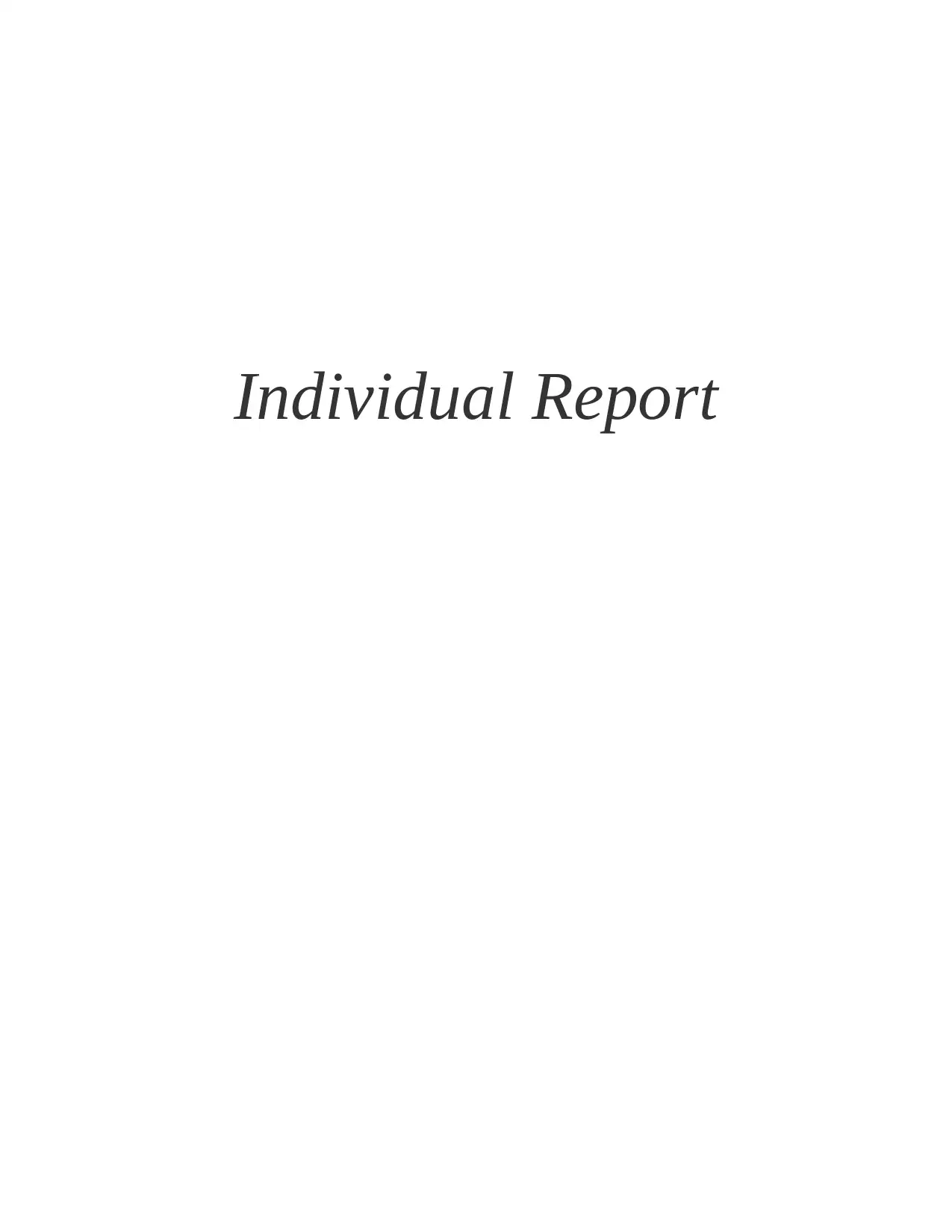
Individual Report
Paraphrase This Document
Need a fresh take? Get an instant paraphrase of this document with our AI Paraphraser
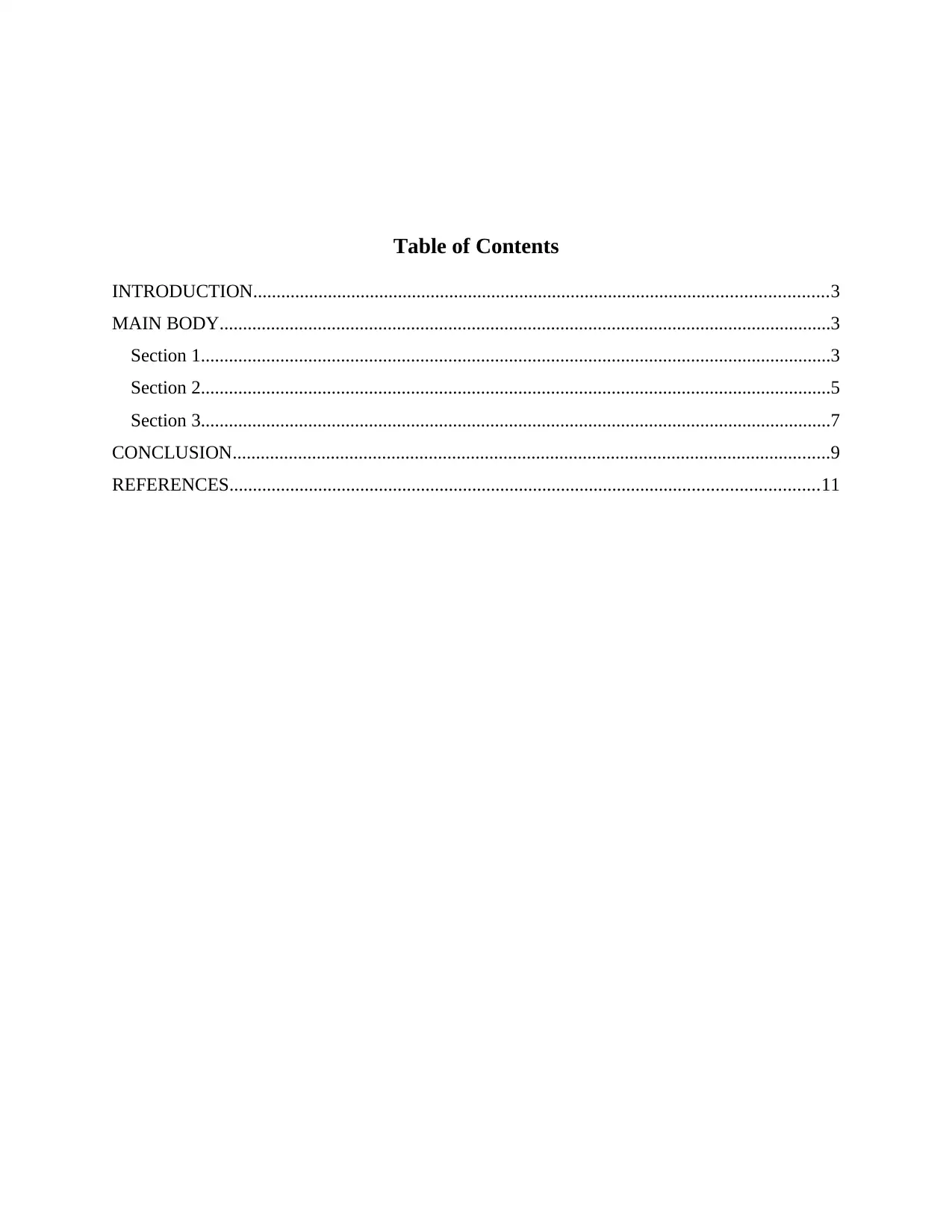
Table of Contents
INTRODUCTION...........................................................................................................................3
MAIN BODY...................................................................................................................................3
Section 1.......................................................................................................................................3
Section 2.......................................................................................................................................5
Section 3.......................................................................................................................................7
CONCLUSION................................................................................................................................9
REFERENCES..............................................................................................................................11
INTRODUCTION...........................................................................................................................3
MAIN BODY...................................................................................................................................3
Section 1.......................................................................................................................................3
Section 2.......................................................................................................................................5
Section 3.......................................................................................................................................7
CONCLUSION................................................................................................................................9
REFERENCES..............................................................................................................................11
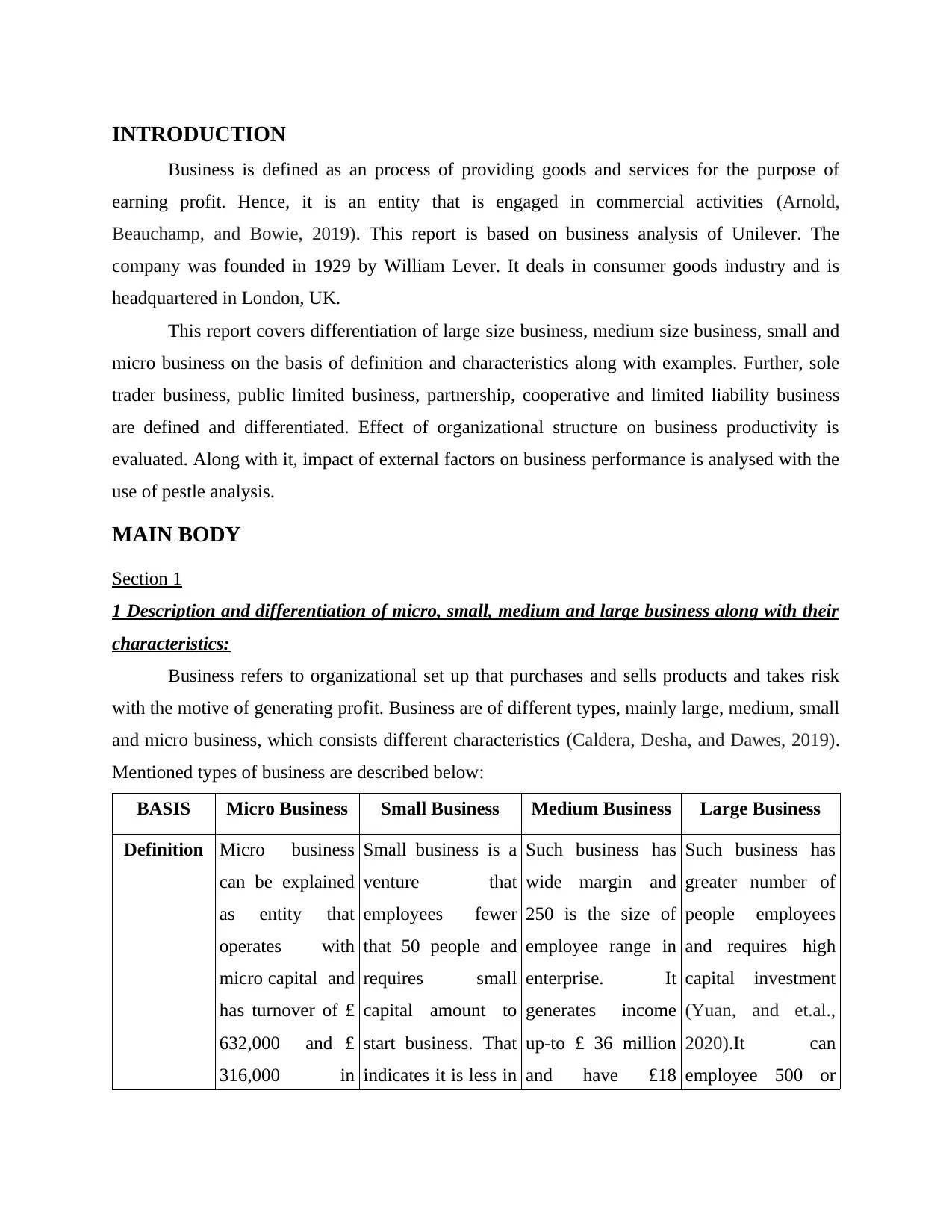
INTRODUCTION
Business is defined as an process of providing goods and services for the purpose of
earning profit. Hence, it is an entity that is engaged in commercial activities (Arnold,
Beauchamp, and Bowie, 2019). This report is based on business analysis of Unilever. The
company was founded in 1929 by William Lever. It deals in consumer goods industry and is
headquartered in London, UK.
This report covers differentiation of large size business, medium size business, small and
micro business on the basis of definition and characteristics along with examples. Further, sole
trader business, public limited business, partnership, cooperative and limited liability business
are defined and differentiated. Effect of organizational structure on business productivity is
evaluated. Along with it, impact of external factors on business performance is analysed with the
use of pestle analysis.
MAIN BODY
Section 1
1 Description and differentiation of micro, small, medium and large business along with their
characteristics:
Business refers to organizational set up that purchases and sells products and takes risk
with the motive of generating profit. Business are of different types, mainly large, medium, small
and micro business, which consists different characteristics (Caldera, Desha, and Dawes, 2019).
Mentioned types of business are described below:
BASIS Micro Business Small Business Medium Business Large Business
Definition Micro business
can be explained
as entity that
operates with
micro capital and
has turnover of £
632,000 and £
316,000 in
Small business is a
venture that
employees fewer
that 50 people and
requires small
capital amount to
start business. That
indicates it is less in
Such business has
wide margin and
250 is the size of
employee range in
enterprise. It
generates income
up-to £ 36 million
and have £18
Such business has
greater number of
people employees
and requires high
capital investment
(Yuan, and et.al.,
2020).It can
employee 500 or
Business is defined as an process of providing goods and services for the purpose of
earning profit. Hence, it is an entity that is engaged in commercial activities (Arnold,
Beauchamp, and Bowie, 2019). This report is based on business analysis of Unilever. The
company was founded in 1929 by William Lever. It deals in consumer goods industry and is
headquartered in London, UK.
This report covers differentiation of large size business, medium size business, small and
micro business on the basis of definition and characteristics along with examples. Further, sole
trader business, public limited business, partnership, cooperative and limited liability business
are defined and differentiated. Effect of organizational structure on business productivity is
evaluated. Along with it, impact of external factors on business performance is analysed with the
use of pestle analysis.
MAIN BODY
Section 1
1 Description and differentiation of micro, small, medium and large business along with their
characteristics:
Business refers to organizational set up that purchases and sells products and takes risk
with the motive of generating profit. Business are of different types, mainly large, medium, small
and micro business, which consists different characteristics (Caldera, Desha, and Dawes, 2019).
Mentioned types of business are described below:
BASIS Micro Business Small Business Medium Business Large Business
Definition Micro business
can be explained
as entity that
operates with
micro capital and
has turnover of £
632,000 and £
316,000 in
Small business is a
venture that
employees fewer
that 50 people and
requires small
capital amount to
start business. That
indicates it is less in
Such business has
wide margin and
250 is the size of
employee range in
enterprise. It
generates income
up-to £ 36 million
and have £18
Such business has
greater number of
people employees
and requires high
capital investment
(Yuan, and et.al.,
2020).It can
employee 500 or
⊘ This is a preview!⊘
Do you want full access?
Subscribe today to unlock all pages.

Trusted by 1+ million students worldwide
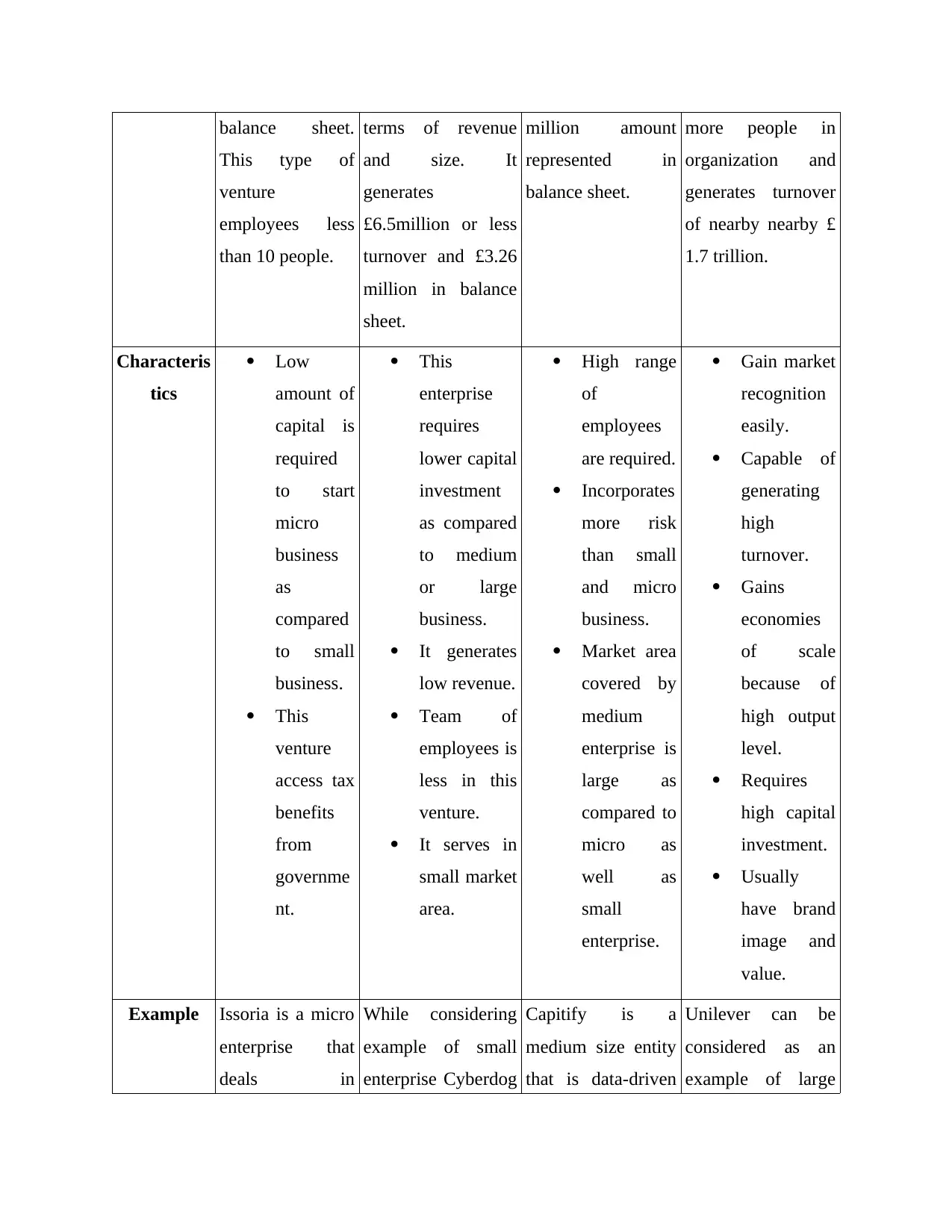
balance sheet.
This type of
venture
employees less
than 10 people.
terms of revenue
and size. It
generates
£6.5million or less
turnover and £3.26
million in balance
sheet.
million amount
represented in
balance sheet.
more people in
organization and
generates turnover
of nearby nearby £
1.7 trillion.
Characteris
tics
Low
amount of
capital is
required
to start
micro
business
as
compared
to small
business.
This
venture
access tax
benefits
from
governme
nt.
This
enterprise
requires
lower capital
investment
as compared
to medium
or large
business.
It generates
low revenue.
Team of
employees is
less in this
venture.
It serves in
small market
area.
High range
of
employees
are required.
Incorporates
more risk
than small
and micro
business.
Market area
covered by
medium
enterprise is
large as
compared to
micro as
well as
small
enterprise.
Gain market
recognition
easily.
Capable of
generating
high
turnover.
Gains
economies
of scale
because of
high output
level.
Requires
high capital
investment.
Usually
have brand
image and
value.
Example Issoria is a micro
enterprise that
deals in
While considering
example of small
enterprise Cyberdog
Capitify is a
medium size entity
that is data-driven
Unilever can be
considered as an
example of large
This type of
venture
employees less
than 10 people.
terms of revenue
and size. It
generates
£6.5million or less
turnover and £3.26
million in balance
sheet.
million amount
represented in
balance sheet.
more people in
organization and
generates turnover
of nearby nearby £
1.7 trillion.
Characteris
tics
Low
amount of
capital is
required
to start
micro
business
as
compared
to small
business.
This
venture
access tax
benefits
from
governme
nt.
This
enterprise
requires
lower capital
investment
as compared
to medium
or large
business.
It generates
low revenue.
Team of
employees is
less in this
venture.
It serves in
small market
area.
High range
of
employees
are required.
Incorporates
more risk
than small
and micro
business.
Market area
covered by
medium
enterprise is
large as
compared to
micro as
well as
small
enterprise.
Gain market
recognition
easily.
Capable of
generating
high
turnover.
Gains
economies
of scale
because of
high output
level.
Requires
high capital
investment.
Usually
have brand
image and
value.
Example Issoria is a micro
enterprise that
deals in
While considering
example of small
enterprise Cyberdog
Capitify is a
medium size entity
that is data-driven
Unilever can be
considered as an
example of large
Paraphrase This Document
Need a fresh take? Get an instant paraphrase of this document with our AI Paraphraser
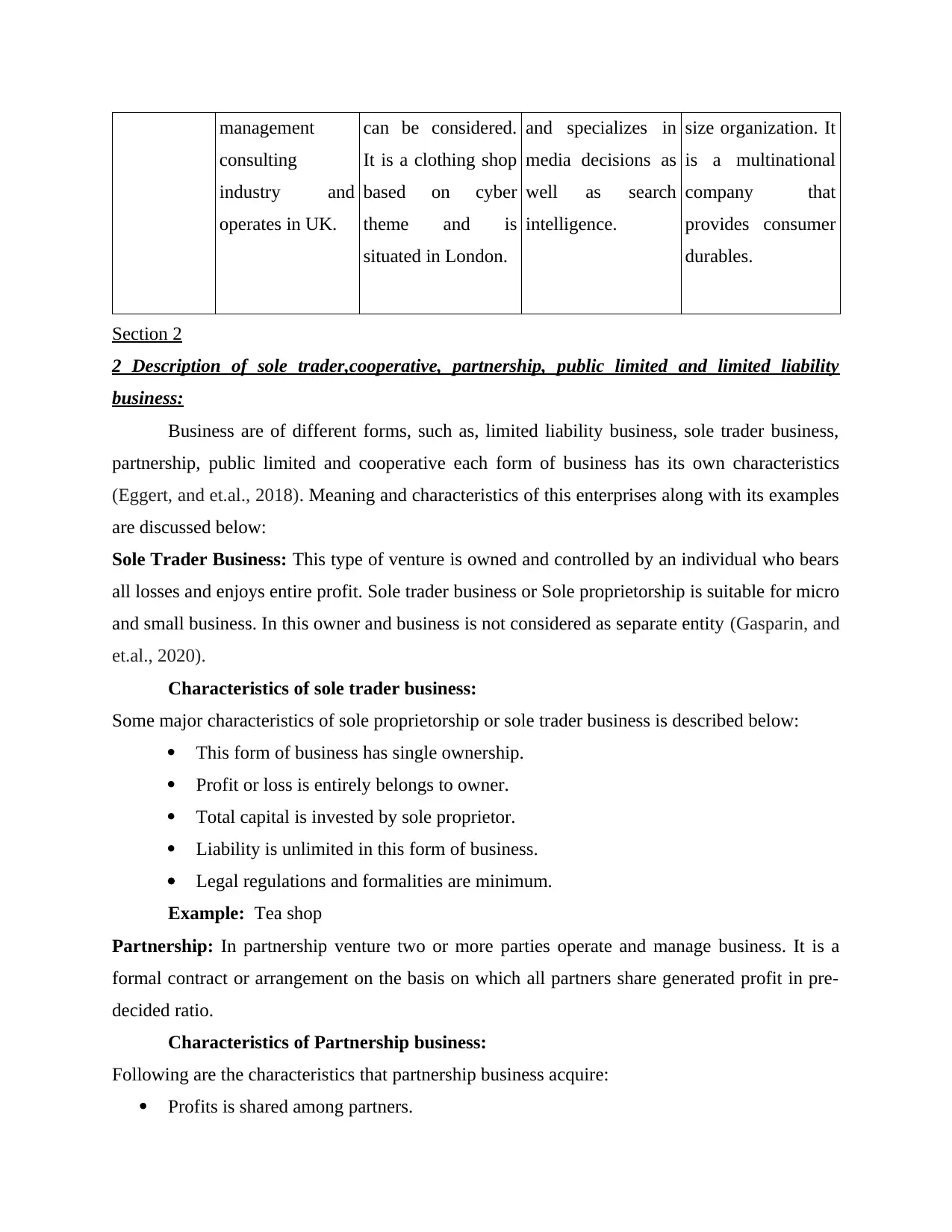
management
consulting
industry and
operates in UK.
can be considered.
It is a clothing shop
based on cyber
theme and is
situated in London.
and specializes in
media decisions as
well as search
intelligence.
size organization. It
is a multinational
company that
provides consumer
durables.
Section 2
2 Description of sole trader,cooperative, partnership, public limited and limited liability
business:
Business are of different forms, such as, limited liability business, sole trader business,
partnership, public limited and cooperative each form of business has its own characteristics
(Eggert, and et.al., 2018). Meaning and characteristics of this enterprises along with its examples
are discussed below:
Sole Trader Business: This type of venture is owned and controlled by an individual who bears
all losses and enjoys entire profit. Sole trader business or Sole proprietorship is suitable for micro
and small business. In this owner and business is not considered as separate entity (Gasparin, and
et.al., 2020).
Characteristics of sole trader business:
Some major characteristics of sole proprietorship or sole trader business is described below:
This form of business has single ownership.
Profit or loss is entirely belongs to owner.
Total capital is invested by sole proprietor.
Liability is unlimited in this form of business.
Legal regulations and formalities are minimum.
Example: Tea shop
Partnership: In partnership venture two or more parties operate and manage business. It is a
formal contract or arrangement on the basis on which all partners share generated profit in pre-
decided ratio.
Characteristics of Partnership business:
Following are the characteristics that partnership business acquire:
Profits is shared among partners.
consulting
industry and
operates in UK.
can be considered.
It is a clothing shop
based on cyber
theme and is
situated in London.
and specializes in
media decisions as
well as search
intelligence.
size organization. It
is a multinational
company that
provides consumer
durables.
Section 2
2 Description of sole trader,cooperative, partnership, public limited and limited liability
business:
Business are of different forms, such as, limited liability business, sole trader business,
partnership, public limited and cooperative each form of business has its own characteristics
(Eggert, and et.al., 2018). Meaning and characteristics of this enterprises along with its examples
are discussed below:
Sole Trader Business: This type of venture is owned and controlled by an individual who bears
all losses and enjoys entire profit. Sole trader business or Sole proprietorship is suitable for micro
and small business. In this owner and business is not considered as separate entity (Gasparin, and
et.al., 2020).
Characteristics of sole trader business:
Some major characteristics of sole proprietorship or sole trader business is described below:
This form of business has single ownership.
Profit or loss is entirely belongs to owner.
Total capital is invested by sole proprietor.
Liability is unlimited in this form of business.
Legal regulations and formalities are minimum.
Example: Tea shop
Partnership: In partnership venture two or more parties operate and manage business. It is a
formal contract or arrangement on the basis on which all partners share generated profit in pre-
decided ratio.
Characteristics of Partnership business:
Following are the characteristics that partnership business acquire:
Profits is shared among partners.
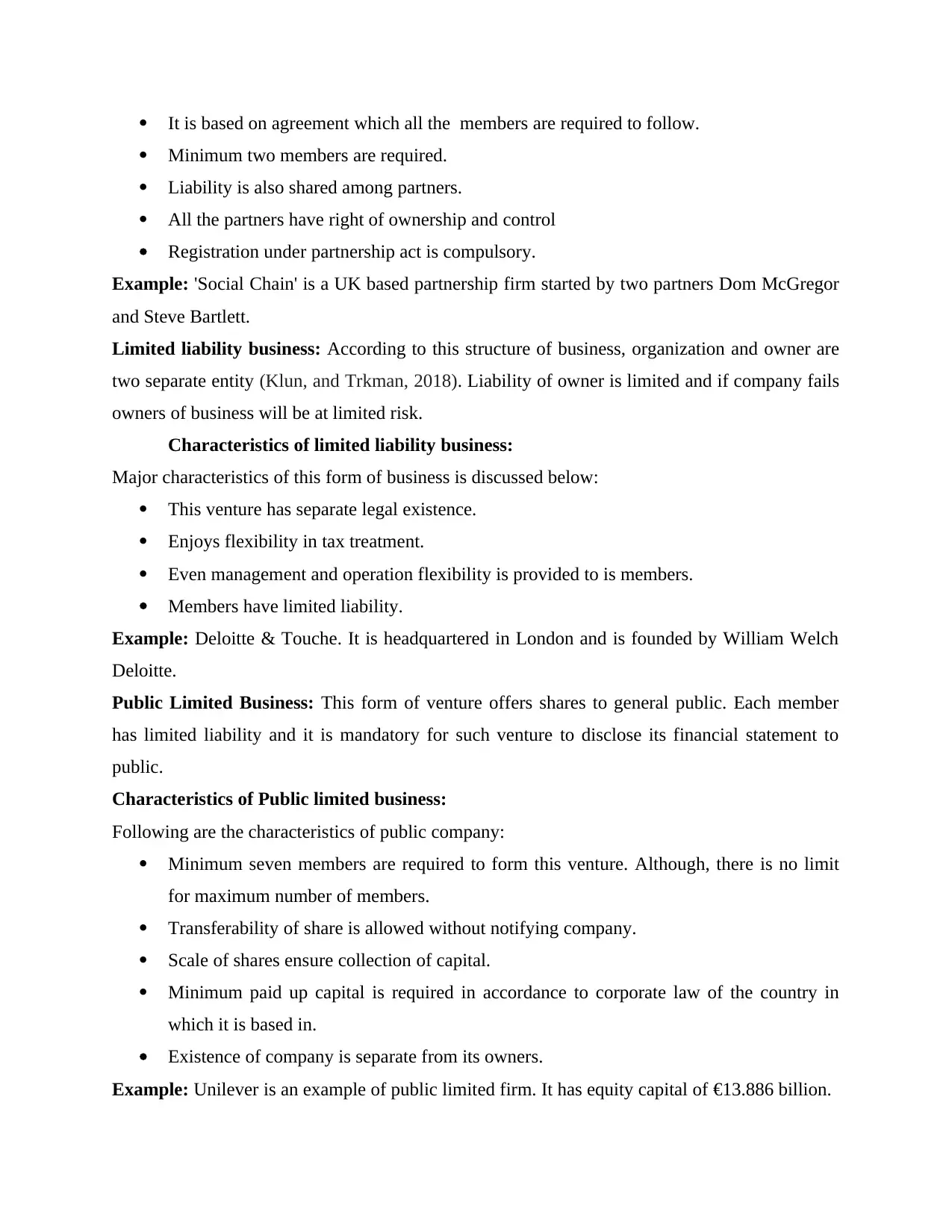
It is based on agreement which all the members are required to follow.
Minimum two members are required.
Liability is also shared among partners.
All the partners have right of ownership and control
Registration under partnership act is compulsory.
Example: 'Social Chain' is a UK based partnership firm started by two partners Dom McGregor
and Steve Bartlett.
Limited liability business: According to this structure of business, organization and owner are
two separate entity (Klun, and Trkman, 2018). Liability of owner is limited and if company fails
owners of business will be at limited risk.
Characteristics of limited liability business:
Major characteristics of this form of business is discussed below:
This venture has separate legal existence.
Enjoys flexibility in tax treatment.
Even management and operation flexibility is provided to is members.
Members have limited liability.
Example: Deloitte & Touche. It is headquartered in London and is founded by William Welch
Deloitte.
Public Limited Business: This form of venture offers shares to general public. Each member
has limited liability and it is mandatory for such venture to disclose its financial statement to
public.
Characteristics of Public limited business:
Following are the characteristics of public company:
Minimum seven members are required to form this venture. Although, there is no limit
for maximum number of members.
Transferability of share is allowed without notifying company.
Scale of shares ensure collection of capital.
Minimum paid up capital is required in accordance to corporate law of the country in
which it is based in.
Existence of company is separate from its owners.
Example: Unilever is an example of public limited firm. It has equity capital of €13.886 billion.
Minimum two members are required.
Liability is also shared among partners.
All the partners have right of ownership and control
Registration under partnership act is compulsory.
Example: 'Social Chain' is a UK based partnership firm started by two partners Dom McGregor
and Steve Bartlett.
Limited liability business: According to this structure of business, organization and owner are
two separate entity (Klun, and Trkman, 2018). Liability of owner is limited and if company fails
owners of business will be at limited risk.
Characteristics of limited liability business:
Major characteristics of this form of business is discussed below:
This venture has separate legal existence.
Enjoys flexibility in tax treatment.
Even management and operation flexibility is provided to is members.
Members have limited liability.
Example: Deloitte & Touche. It is headquartered in London and is founded by William Welch
Deloitte.
Public Limited Business: This form of venture offers shares to general public. Each member
has limited liability and it is mandatory for such venture to disclose its financial statement to
public.
Characteristics of Public limited business:
Following are the characteristics of public company:
Minimum seven members are required to form this venture. Although, there is no limit
for maximum number of members.
Transferability of share is allowed without notifying company.
Scale of shares ensure collection of capital.
Minimum paid up capital is required in accordance to corporate law of the country in
which it is based in.
Existence of company is separate from its owners.
Example: Unilever is an example of public limited firm. It has equity capital of €13.886 billion.
⊘ This is a preview!⊘
Do you want full access?
Subscribe today to unlock all pages.

Trusted by 1+ million students worldwide
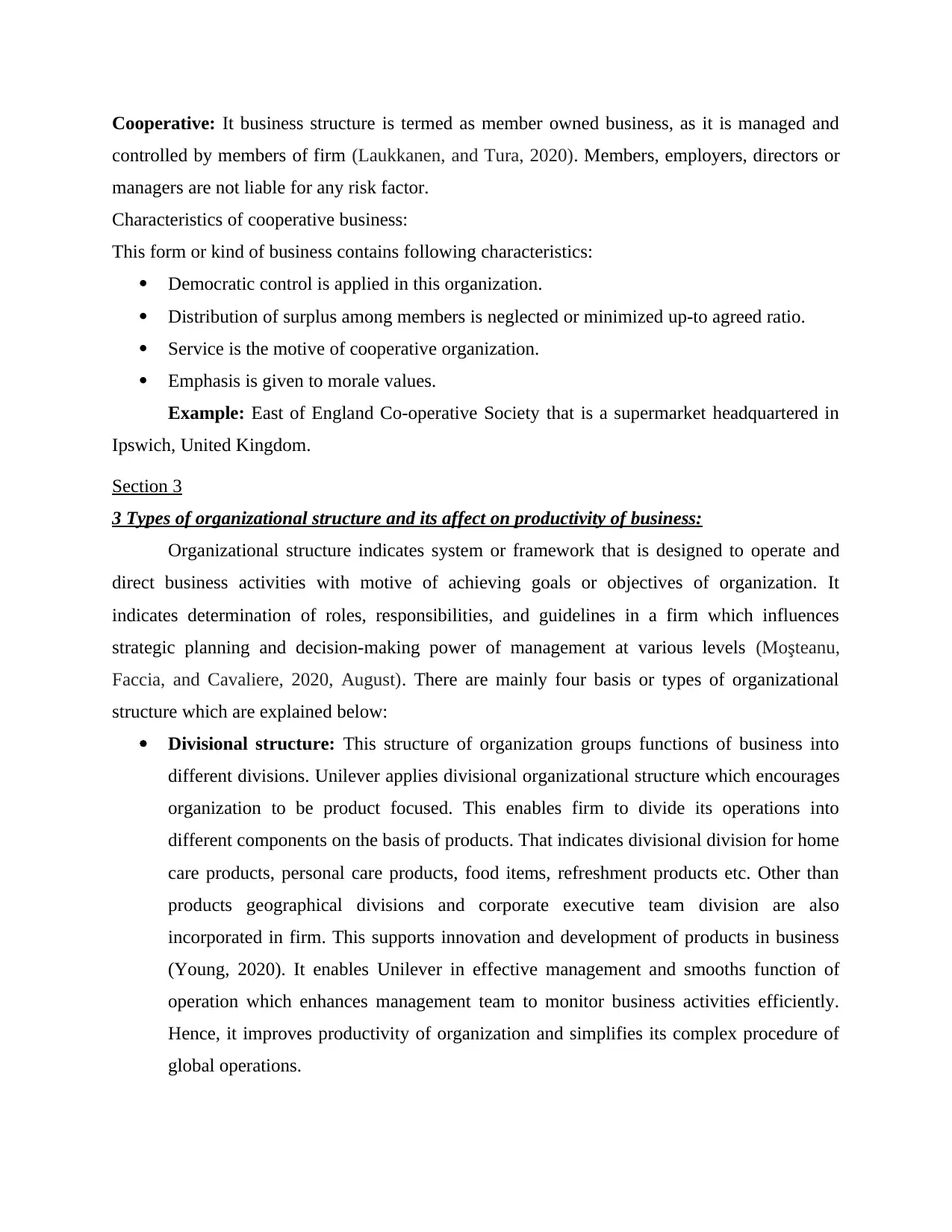
Cooperative: It business structure is termed as member owned business, as it is managed and
controlled by members of firm (Laukkanen, and Tura, 2020). Members, employers, directors or
managers are not liable for any risk factor.
Characteristics of cooperative business:
This form or kind of business contains following characteristics:
Democratic control is applied in this organization.
Distribution of surplus among members is neglected or minimized up-to agreed ratio.
Service is the motive of cooperative organization.
Emphasis is given to morale values.
Example: East of England Co-operative Society that is a supermarket headquartered in
Ipswich, United Kingdom.
Section 3
3 Types of organizational structure and its affect on productivity of business:
Organizational structure indicates system or framework that is designed to operate and
direct business activities with motive of achieving goals or objectives of organization. It
indicates determination of roles, responsibilities, and guidelines in a firm which influences
strategic planning and decision-making power of management at various levels (Moşteanu,
Faccia, and Cavaliere, 2020, August). There are mainly four basis or types of organizational
structure which are explained below:
Divisional structure: This structure of organization groups functions of business into
different divisions. Unilever applies divisional organizational structure which encourages
organization to be product focused. This enables firm to divide its operations into
different components on the basis of products. That indicates divisional division for home
care products, personal care products, food items, refreshment products etc. Other than
products geographical divisions and corporate executive team division are also
incorporated in firm. This supports innovation and development of products in business
(Young, 2020). It enables Unilever in effective management and smooths function of
operation which enhances management team to monitor business activities efficiently.
Hence, it improves productivity of organization and simplifies its complex procedure of
global operations.
controlled by members of firm (Laukkanen, and Tura, 2020). Members, employers, directors or
managers are not liable for any risk factor.
Characteristics of cooperative business:
This form or kind of business contains following characteristics:
Democratic control is applied in this organization.
Distribution of surplus among members is neglected or minimized up-to agreed ratio.
Service is the motive of cooperative organization.
Emphasis is given to morale values.
Example: East of England Co-operative Society that is a supermarket headquartered in
Ipswich, United Kingdom.
Section 3
3 Types of organizational structure and its affect on productivity of business:
Organizational structure indicates system or framework that is designed to operate and
direct business activities with motive of achieving goals or objectives of organization. It
indicates determination of roles, responsibilities, and guidelines in a firm which influences
strategic planning and decision-making power of management at various levels (Moşteanu,
Faccia, and Cavaliere, 2020, August). There are mainly four basis or types of organizational
structure which are explained below:
Divisional structure: This structure of organization groups functions of business into
different divisions. Unilever applies divisional organizational structure which encourages
organization to be product focused. This enables firm to divide its operations into
different components on the basis of products. That indicates divisional division for home
care products, personal care products, food items, refreshment products etc. Other than
products geographical divisions and corporate executive team division are also
incorporated in firm. This supports innovation and development of products in business
(Young, 2020). It enables Unilever in effective management and smooths function of
operation which enhances management team to monitor business activities efficiently.
Hence, it improves productivity of organization and simplifies its complex procedure of
global operations.
Paraphrase This Document
Need a fresh take? Get an instant paraphrase of this document with our AI Paraphraser
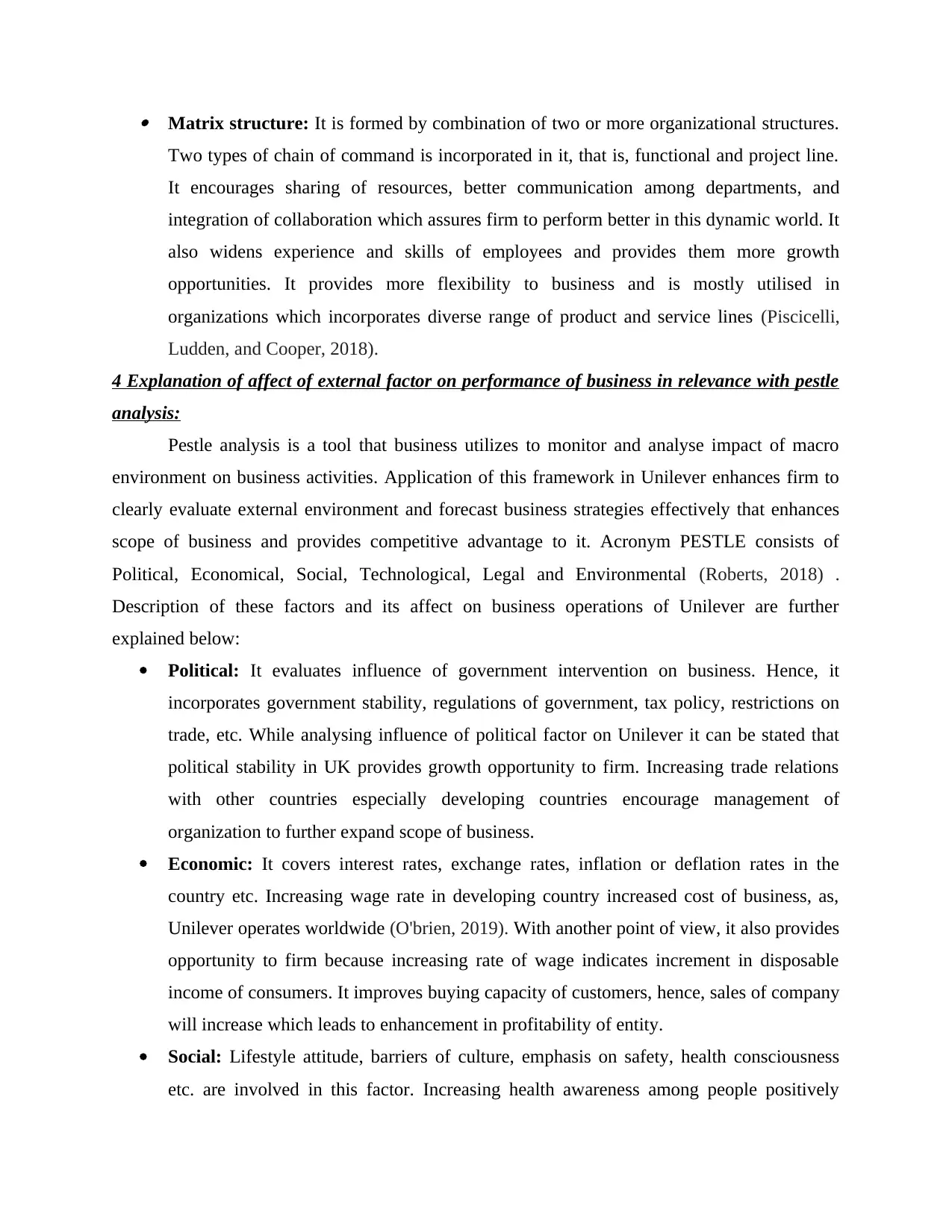
Matrix structure: It is formed by combination of two or more organizational structures.
Two types of chain of command is incorporated in it, that is, functional and project line.
It encourages sharing of resources, better communication among departments, and
integration of collaboration which assures firm to perform better in this dynamic world. It
also widens experience and skills of employees and provides them more growth
opportunities. It provides more flexibility to business and is mostly utilised in
organizations which incorporates diverse range of product and service lines (Piscicelli,
Ludden, and Cooper, 2018).
4 Explanation of affect of external factor on performance of business in relevance with pestle
analysis:
Pestle analysis is a tool that business utilizes to monitor and analyse impact of macro
environment on business activities. Application of this framework in Unilever enhances firm to
clearly evaluate external environment and forecast business strategies effectively that enhances
scope of business and provides competitive advantage to it. Acronym PESTLE consists of
Political, Economical, Social, Technological, Legal and Environmental (Roberts, 2018) .
Description of these factors and its affect on business operations of Unilever are further
explained below:
Political: It evaluates influence of government intervention on business. Hence, it
incorporates government stability, regulations of government, tax policy, restrictions on
trade, etc. While analysing influence of political factor on Unilever it can be stated that
political stability in UK provides growth opportunity to firm. Increasing trade relations
with other countries especially developing countries encourage management of
organization to further expand scope of business.
Economic: It covers interest rates, exchange rates, inflation or deflation rates in the
country etc. Increasing wage rate in developing country increased cost of business, as,
Unilever operates worldwide (O'brien, 2019). With another point of view, it also provides
opportunity to firm because increasing rate of wage indicates increment in disposable
income of consumers. It improves buying capacity of customers, hence, sales of company
will increase which leads to enhancement in profitability of entity.
Social: Lifestyle attitude, barriers of culture, emphasis on safety, health consciousness
etc. are involved in this factor. Increasing health awareness among people positively
Two types of chain of command is incorporated in it, that is, functional and project line.
It encourages sharing of resources, better communication among departments, and
integration of collaboration which assures firm to perform better in this dynamic world. It
also widens experience and skills of employees and provides them more growth
opportunities. It provides more flexibility to business and is mostly utilised in
organizations which incorporates diverse range of product and service lines (Piscicelli,
Ludden, and Cooper, 2018).
4 Explanation of affect of external factor on performance of business in relevance with pestle
analysis:
Pestle analysis is a tool that business utilizes to monitor and analyse impact of macro
environment on business activities. Application of this framework in Unilever enhances firm to
clearly evaluate external environment and forecast business strategies effectively that enhances
scope of business and provides competitive advantage to it. Acronym PESTLE consists of
Political, Economical, Social, Technological, Legal and Environmental (Roberts, 2018) .
Description of these factors and its affect on business operations of Unilever are further
explained below:
Political: It evaluates influence of government intervention on business. Hence, it
incorporates government stability, regulations of government, tax policy, restrictions on
trade, etc. While analysing influence of political factor on Unilever it can be stated that
political stability in UK provides growth opportunity to firm. Increasing trade relations
with other countries especially developing countries encourage management of
organization to further expand scope of business.
Economic: It covers interest rates, exchange rates, inflation or deflation rates in the
country etc. Increasing wage rate in developing country increased cost of business, as,
Unilever operates worldwide (O'brien, 2019). With another point of view, it also provides
opportunity to firm because increasing rate of wage indicates increment in disposable
income of consumers. It improves buying capacity of customers, hence, sales of company
will increase which leads to enhancement in profitability of entity.
Social: Lifestyle attitude, barriers of culture, emphasis on safety, health consciousness
etc. are involved in this factor. Increasing health awareness among people positively
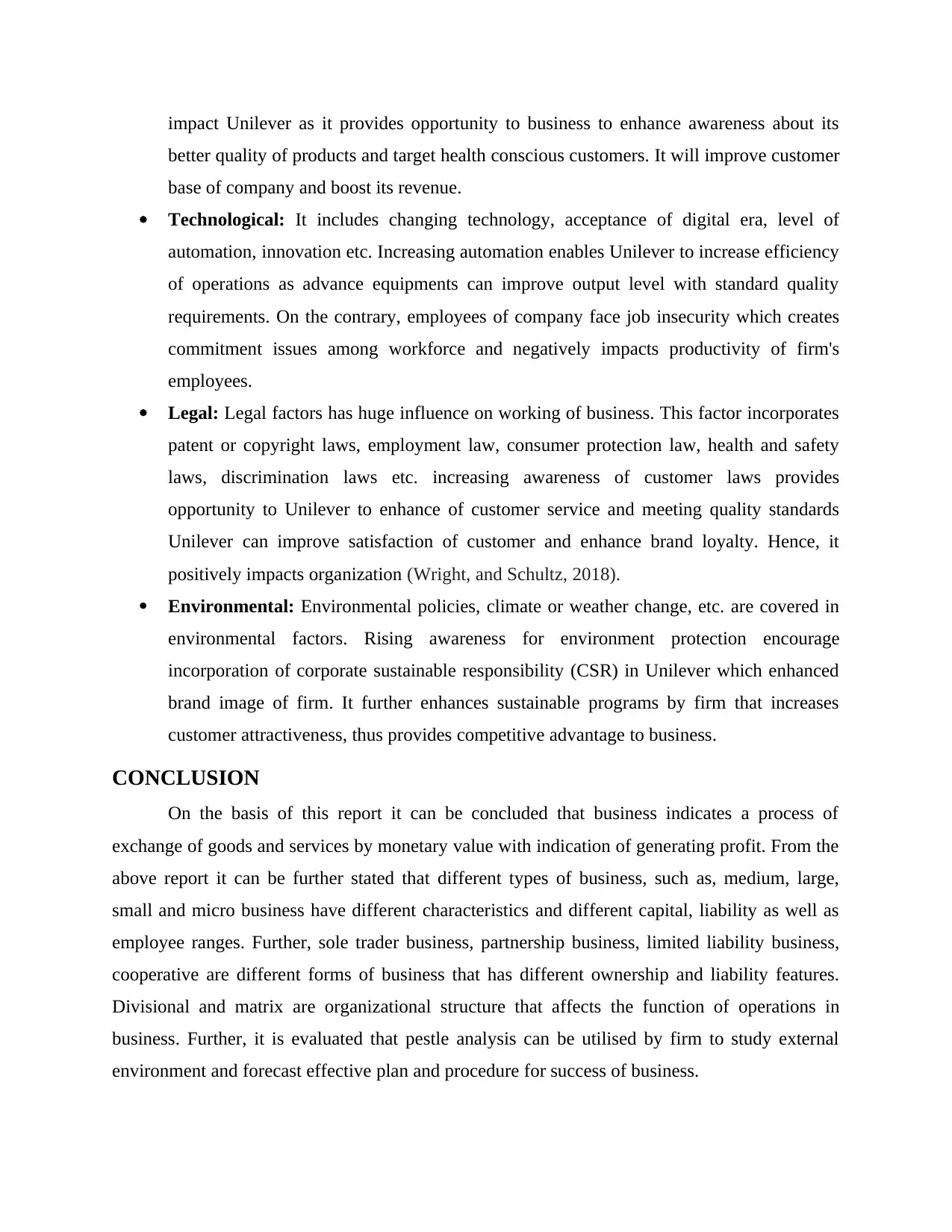
impact Unilever as it provides opportunity to business to enhance awareness about its
better quality of products and target health conscious customers. It will improve customer
base of company and boost its revenue.
Technological: It includes changing technology, acceptance of digital era, level of
automation, innovation etc. Increasing automation enables Unilever to increase efficiency
of operations as advance equipments can improve output level with standard quality
requirements. On the contrary, employees of company face job insecurity which creates
commitment issues among workforce and negatively impacts productivity of firm's
employees.
Legal: Legal factors has huge influence on working of business. This factor incorporates
patent or copyright laws, employment law, consumer protection law, health and safety
laws, discrimination laws etc. increasing awareness of customer laws provides
opportunity to Unilever to enhance of customer service and meeting quality standards
Unilever can improve satisfaction of customer and enhance brand loyalty. Hence, it
positively impacts organization (Wright, and Schultz, 2018).
Environmental: Environmental policies, climate or weather change, etc. are covered in
environmental factors. Rising awareness for environment protection encourage
incorporation of corporate sustainable responsibility (CSR) in Unilever which enhanced
brand image of firm. It further enhances sustainable programs by firm that increases
customer attractiveness, thus provides competitive advantage to business.
CONCLUSION
On the basis of this report it can be concluded that business indicates a process of
exchange of goods and services by monetary value with indication of generating profit. From the
above report it can be further stated that different types of business, such as, medium, large,
small and micro business have different characteristics and different capital, liability as well as
employee ranges. Further, sole trader business, partnership business, limited liability business,
cooperative are different forms of business that has different ownership and liability features.
Divisional and matrix are organizational structure that affects the function of operations in
business. Further, it is evaluated that pestle analysis can be utilised by firm to study external
environment and forecast effective plan and procedure for success of business.
better quality of products and target health conscious customers. It will improve customer
base of company and boost its revenue.
Technological: It includes changing technology, acceptance of digital era, level of
automation, innovation etc. Increasing automation enables Unilever to increase efficiency
of operations as advance equipments can improve output level with standard quality
requirements. On the contrary, employees of company face job insecurity which creates
commitment issues among workforce and negatively impacts productivity of firm's
employees.
Legal: Legal factors has huge influence on working of business. This factor incorporates
patent or copyright laws, employment law, consumer protection law, health and safety
laws, discrimination laws etc. increasing awareness of customer laws provides
opportunity to Unilever to enhance of customer service and meeting quality standards
Unilever can improve satisfaction of customer and enhance brand loyalty. Hence, it
positively impacts organization (Wright, and Schultz, 2018).
Environmental: Environmental policies, climate or weather change, etc. are covered in
environmental factors. Rising awareness for environment protection encourage
incorporation of corporate sustainable responsibility (CSR) in Unilever which enhanced
brand image of firm. It further enhances sustainable programs by firm that increases
customer attractiveness, thus provides competitive advantage to business.
CONCLUSION
On the basis of this report it can be concluded that business indicates a process of
exchange of goods and services by monetary value with indication of generating profit. From the
above report it can be further stated that different types of business, such as, medium, large,
small and micro business have different characteristics and different capital, liability as well as
employee ranges. Further, sole trader business, partnership business, limited liability business,
cooperative are different forms of business that has different ownership and liability features.
Divisional and matrix are organizational structure that affects the function of operations in
business. Further, it is evaluated that pestle analysis can be utilised by firm to study external
environment and forecast effective plan and procedure for success of business.
⊘ This is a preview!⊘
Do you want full access?
Subscribe today to unlock all pages.

Trusted by 1+ million students worldwide
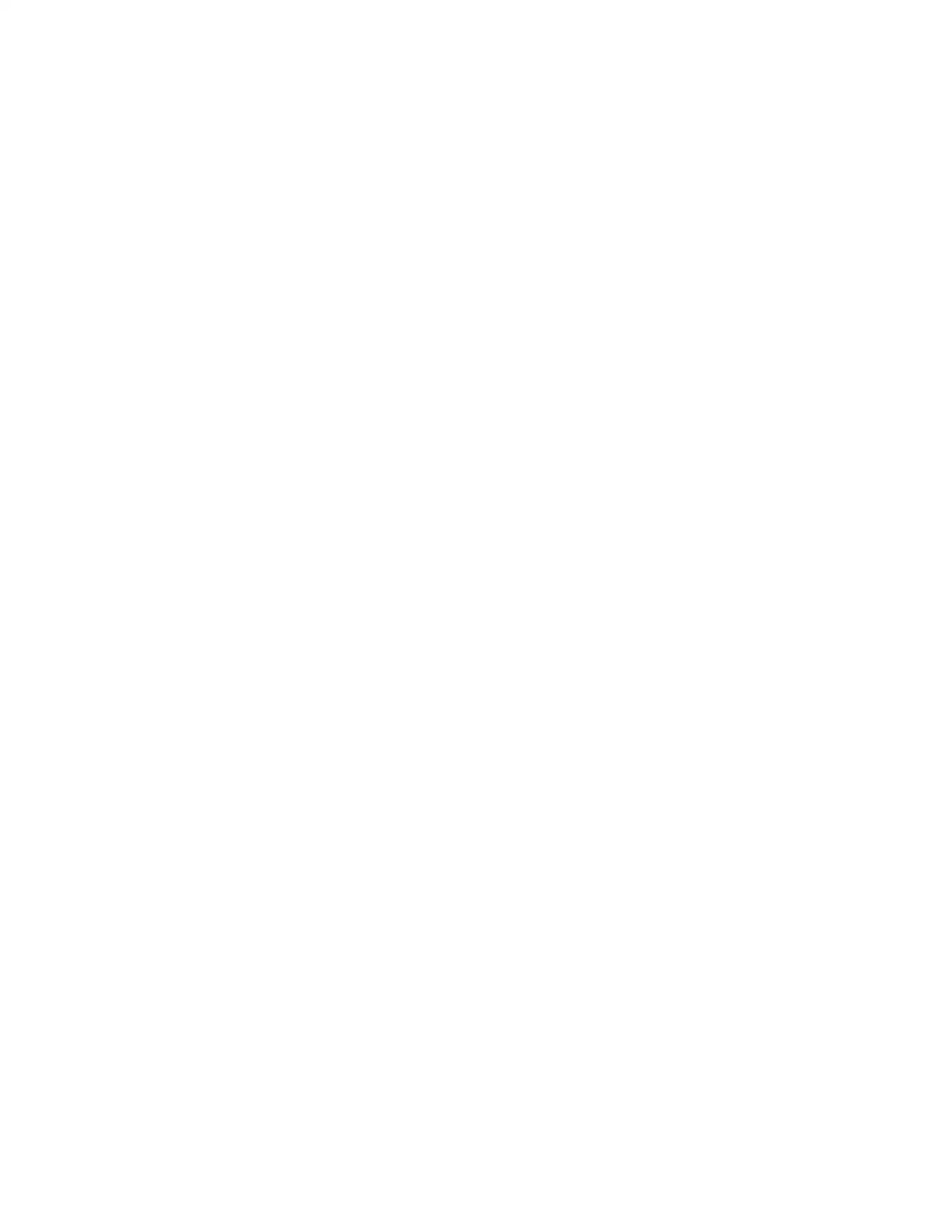
Paraphrase This Document
Need a fresh take? Get an instant paraphrase of this document with our AI Paraphraser
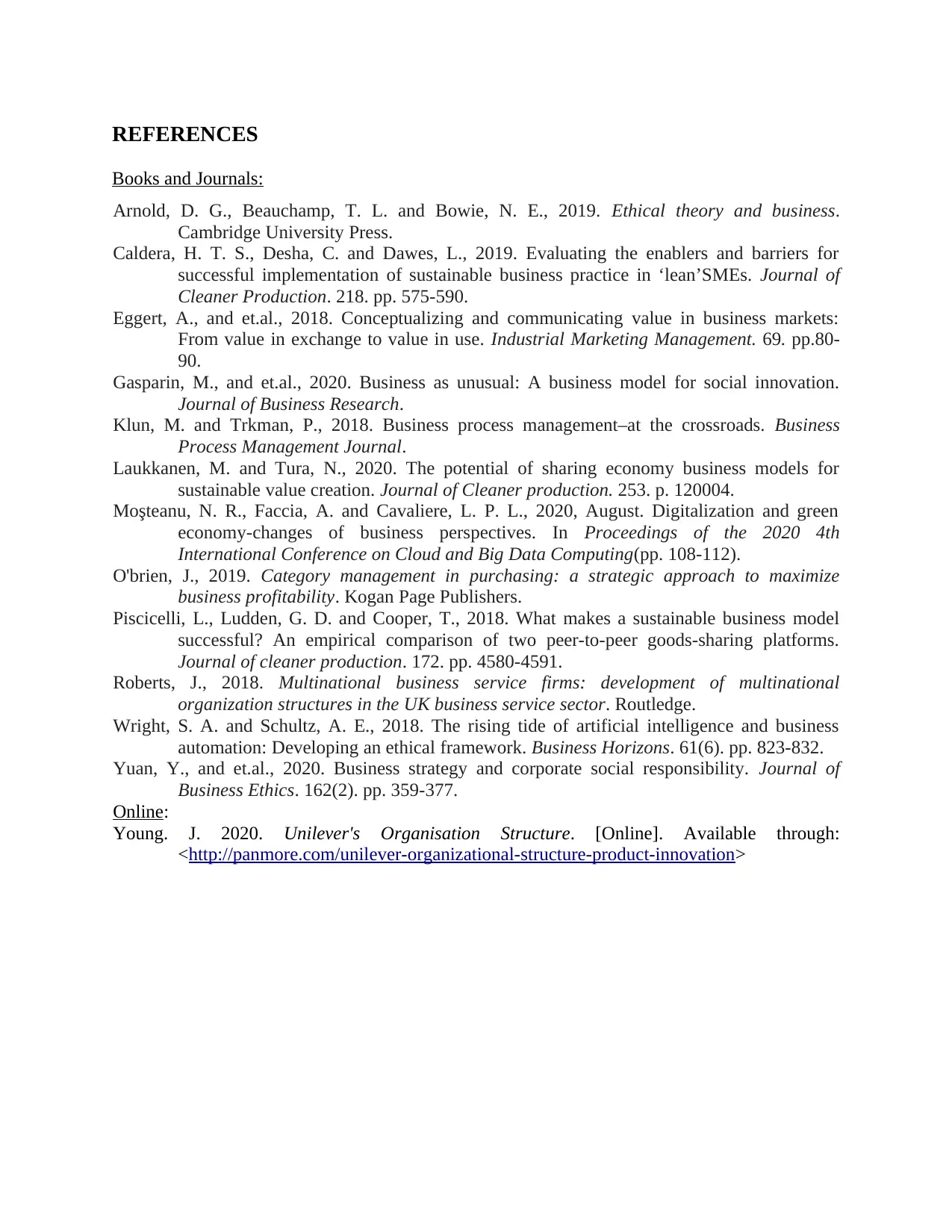
REFERENCES
Books and Journals:
Arnold, D. G., Beauchamp, T. L. and Bowie, N. E., 2019. Ethical theory and business.
Cambridge University Press.
Caldera, H. T. S., Desha, C. and Dawes, L., 2019. Evaluating the enablers and barriers for
successful implementation of sustainable business practice in ‘lean’SMEs. Journal of
Cleaner Production. 218. pp. 575-590.
Eggert, A., and et.al., 2018. Conceptualizing and communicating value in business markets:
From value in exchange to value in use. Industrial Marketing Management. 69. pp.80-
90.
Gasparin, M., and et.al., 2020. Business as unusual: A business model for social innovation.
Journal of Business Research.
Klun, M. and Trkman, P., 2018. Business process management–at the crossroads. Business
Process Management Journal.
Laukkanen, M. and Tura, N., 2020. The potential of sharing economy business models for
sustainable value creation. Journal of Cleaner production. 253. p. 120004.
Moşteanu, N. R., Faccia, A. and Cavaliere, L. P. L., 2020, August. Digitalization and green
economy-changes of business perspectives. In Proceedings of the 2020 4th
International Conference on Cloud and Big Data Computing(pp. 108-112).
O'brien, J., 2019. Category management in purchasing: a strategic approach to maximize
business profitability. Kogan Page Publishers.
Piscicelli, L., Ludden, G. D. and Cooper, T., 2018. What makes a sustainable business model
successful? An empirical comparison of two peer-to-peer goods-sharing platforms.
Journal of cleaner production. 172. pp. 4580-4591.
Roberts, J., 2018. Multinational business service firms: development of multinational
organization structures in the UK business service sector. Routledge.
Wright, S. A. and Schultz, A. E., 2018. The rising tide of artificial intelligence and business
automation: Developing an ethical framework. Business Horizons. 61(6). pp. 823-832.
Yuan, Y., and et.al., 2020. Business strategy and corporate social responsibility. Journal of
Business Ethics. 162(2). pp. 359-377.
Online:
Young. J. 2020. Unilever's Organisation Structure. [Online]. Available through:
<http://panmore.com/unilever-organizational-structure-product-innovation>
Books and Journals:
Arnold, D. G., Beauchamp, T. L. and Bowie, N. E., 2019. Ethical theory and business.
Cambridge University Press.
Caldera, H. T. S., Desha, C. and Dawes, L., 2019. Evaluating the enablers and barriers for
successful implementation of sustainable business practice in ‘lean’SMEs. Journal of
Cleaner Production. 218. pp. 575-590.
Eggert, A., and et.al., 2018. Conceptualizing and communicating value in business markets:
From value in exchange to value in use. Industrial Marketing Management. 69. pp.80-
90.
Gasparin, M., and et.al., 2020. Business as unusual: A business model for social innovation.
Journal of Business Research.
Klun, M. and Trkman, P., 2018. Business process management–at the crossroads. Business
Process Management Journal.
Laukkanen, M. and Tura, N., 2020. The potential of sharing economy business models for
sustainable value creation. Journal of Cleaner production. 253. p. 120004.
Moşteanu, N. R., Faccia, A. and Cavaliere, L. P. L., 2020, August. Digitalization and green
economy-changes of business perspectives. In Proceedings of the 2020 4th
International Conference on Cloud and Big Data Computing(pp. 108-112).
O'brien, J., 2019. Category management in purchasing: a strategic approach to maximize
business profitability. Kogan Page Publishers.
Piscicelli, L., Ludden, G. D. and Cooper, T., 2018. What makes a sustainable business model
successful? An empirical comparison of two peer-to-peer goods-sharing platforms.
Journal of cleaner production. 172. pp. 4580-4591.
Roberts, J., 2018. Multinational business service firms: development of multinational
organization structures in the UK business service sector. Routledge.
Wright, S. A. and Schultz, A. E., 2018. The rising tide of artificial intelligence and business
automation: Developing an ethical framework. Business Horizons. 61(6). pp. 823-832.
Yuan, Y., and et.al., 2020. Business strategy and corporate social responsibility. Journal of
Business Ethics. 162(2). pp. 359-377.
Online:
Young. J. 2020. Unilever's Organisation Structure. [Online]. Available through:
<http://panmore.com/unilever-organizational-structure-product-innovation>
1 out of 11
Related Documents
Your All-in-One AI-Powered Toolkit for Academic Success.
+13062052269
info@desklib.com
Available 24*7 on WhatsApp / Email
![[object Object]](/_next/static/media/star-bottom.7253800d.svg)
Unlock your academic potential
Copyright © 2020–2025 A2Z Services. All Rights Reserved. Developed and managed by ZUCOL.





